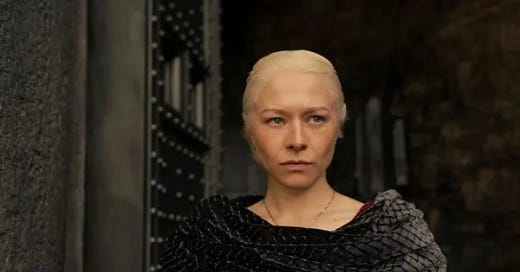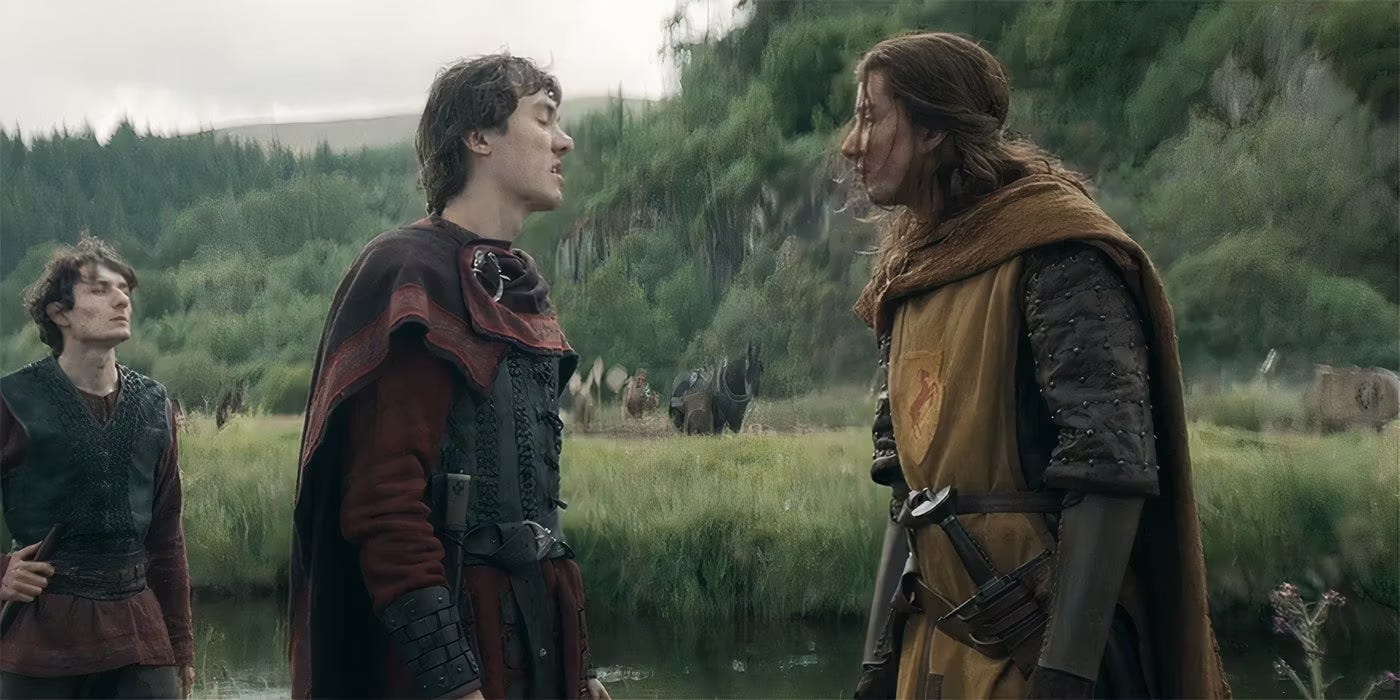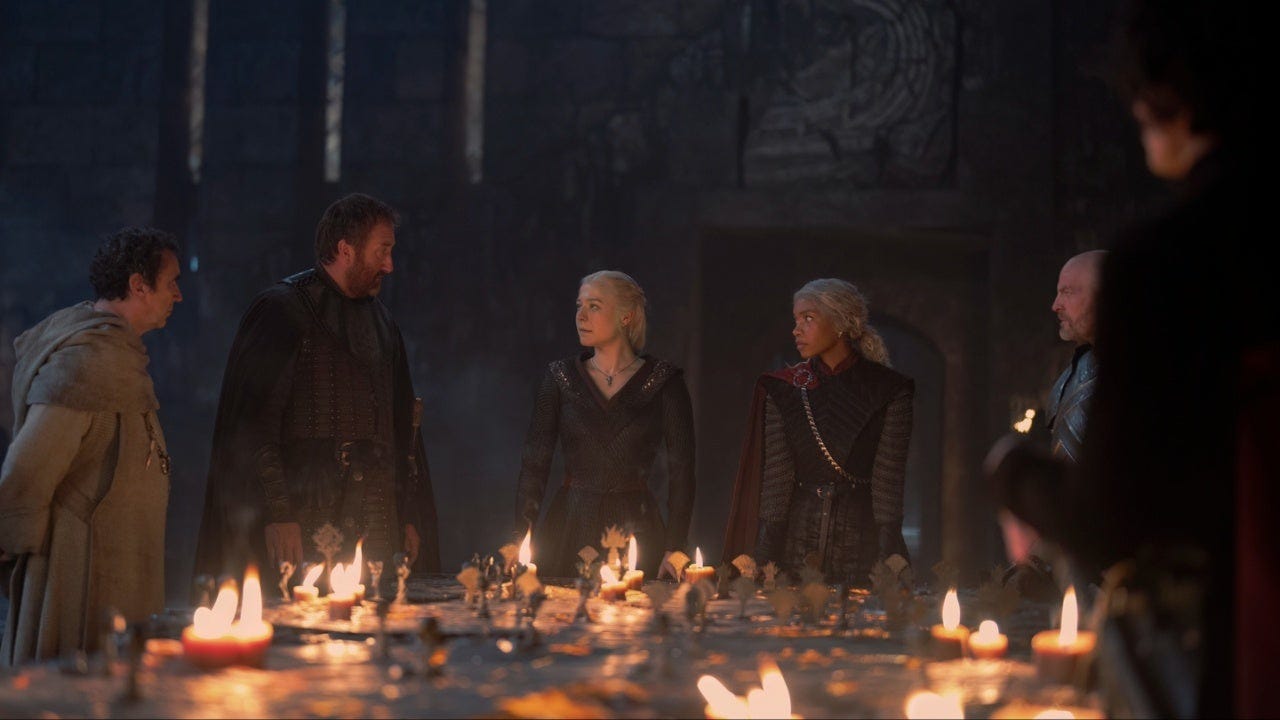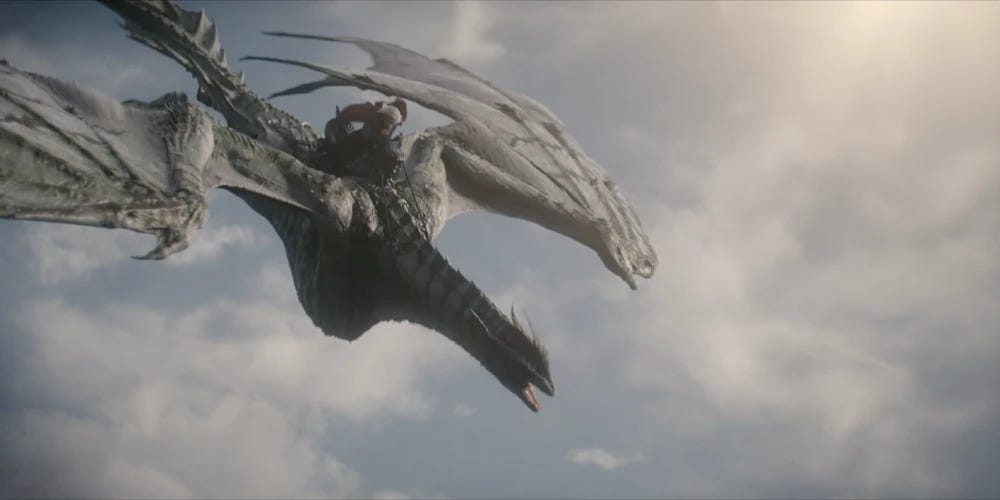The Short Take: And so begins the more familiar Game of Thrones sprawl. That’s exciting because we get to visit new places and meet new characters, yet I’m relieved that the episode still lasers its focus on the core family drama between Team Green and Team Black.
New Dragon Count: 1
Cumulative Dragon Count: 6
[Spoiler WARNING: Do not cross the river of spoilers unless you have seen Season 2 of HotD through Episode 3.]
Image Credit: NYT
The Long Take:
Wars are not declared. We wade into them like a murky bog.
I relish episodes of television that have a clear theme, yet are not so literal or heavy-handed that, say, the title says it all. This week’s House of the Dragon carries the name “The Burning Mill.” Some viewers, I imagine, may be confused about this title. Hey, wasn’t that the place where those random people I don’t know were fighting and then they’re all dead? And the windmills were all burnt? What was that about? I’m being a bit facetious, and don’t mean to demean more casual viewers, of course. But only someone clued into the theme of the episode would understand why the episode title is named after The Battle of the Burning Mill, a conflict at which no member of Team Green or Team Black was actually present. It’s a relatively minor part of the episode in its screentime, as Daemon does his best Scooby Doo impression at at a haunted Harrenhal and, as I’ll discuss at length later, Rhaenyra sneaks into the Sept to try one last parlay with Alicent. And yet, it is the key to understanding those other, more consequential events.
As a kid, I remember being so frustrated in history class when an exam asked what had caused a major historical event because the question would be framed as if there were one, clear-cut answer, but the actual answer would be a confluence of multiple sociopolitical forces or events. Yes, the assassination of Archduke Ferdinand in 1914 was a catalyst for WWI, the spark that lit the “powder keg” that was Europe at the time, but there were a half dozen other moves made after that, before war was officially declared. And the rise of Germany had already upset the balance of power long before a Serbian nationalist group called The Black Hand attacked the presumptive heir to the Austro-Hungarian throne.
The Battle of the Burning Mill feels like the singular event that Westersosi historians would designate as the start of the war, but the richness and narrative pleasure of House of the Dragon, especially this episode, is in witnessing how much more complicated the question of when and how the war between the Greens and the Blacks began really is. You could trace back the problem all the way to Lucerys cutting Daemond’s eye with a knife back in the early ays of Season 1. A schoolyard skirmish gone horribly wrong. But you really could point to any of the horrific missteps since then and say, “No that’s when it really started.” And that’s part of the point of the series. To show how it wasn’t one singular folly that brought war, but a series of incidents that gradually pulled our characters into the depths.
Image Credit: Collider
And when they happens, the fight itself will be reason enough to do harm. And, as Rhaenys says to Rhaenyra, “Soon they will not even remember what it was that began the war in the first place.” For the story this one episode is trying to tell, the Burning Mill serves as thematic reinforcement for the notion we hear echoed in multiple places: that feuds can easily fuel themselves because the hatred for the other side and the hunger to prove oneself in a fight is enough to keep the fire burning. As we see in the opening scene, the slander against Rhaenyra vs. Aegon is just a convenient excuse for the Blackwoods and the Brackens to go at it. This may technically be the first blood spilled in the name of these two competing Targaryen rulers, but right before Davos Bracken mutters “baby killer” under his breath, they were actually fighting over land and where the Bracken border (adorably marked with a pile of rocks) was supposed to be. None of that has to do with the rightful ruler of the Seven Kingdoms.
When I researched what originally started the infamous and often parodied American feud between the Hatfields and the McCoys, I found a similar confusion. Some historians say that the two clans hated each other because they fell on opposite sides of the Civil War. Other accounts argue that in 1878 Randolph McCoy accused Floyd Hatfield of stealing his pig. Others still say it was farther back in 1865 when Asa Harmon McCoy was murdered. So the more practical, mundane disputes of land and hogs become entangled with the larger political conflict. My larger point here, though, is that no one really knows how it started; it just got to a point at which it was and that was enough. It’s important that we not only hear the words about not remembering how a war first began from Rhaenys early int he episode. We need to hear it again out of Ser Simon Strong’s mouth at Harrenhal as he welcomes Daemon as his new Lord. When he explains that Houses Bracken and Blackwood have already gone to war with one another because they have “long detested one another,” Daemon asks why. Strong’s only response is, “Oh, well…the answer to that is…lost in time. Sin begets sin begets sin.” After all we’ve seen from the Targaryen family to date, that phrase reframes the events of the series leading up to this moment as a chain reaction that a.) started this war long ago and b.) will tragically be forgotten in history books.
Image Credit: The Wrap
It becomes doubly interesting, then, that writer David Hancock juxtaposes this relatively more pedestrian, perhaps even buffoonish (Maybe cartoonish? For whatever reason I always imagine the Hatfields and McCoys as Looney Tunes?) Hatfield v. McCoy type feud with Rhaenyra and Alicent meeting in secret to see if they can pull back from the brink of war. [Cue Arrested Development voice: They can’t.] For one, to see in real time the formation of another Bracken vs. Blackwood conflict while we as viewers still can recognize the nuances of who did what to whom and why (that has, of course, been the whole point of the show thus far) is unsettling. And secondly, it projects a very nihilistic outlook onto conflicts like this. It almost never mattered what Rhaenyra said to Alicent in the Sept; no matter how hopeful Rhaenys was in encouraging Rhaenyra to give peace one more chance, it never would have made a difference because we were already at the Hatfield and McCoy stage. Alicent, tragically, implies that she has lost all her power and can no longer influence her bloodthirsty sons. She doesn’t even have her father, Otto Hightower, to help Aegon and Aemond see reason.
The conversation between Rhaenyra and Alicent — which was the most thrilling and tense scene in the entire episode — actually brought up another potential candidate for the starting point of the war. One could argue that this goes all the way back to the original schism between two young friends who, as Rhaenyra reminds Alicent, used to sit together at tourneys and complain about how vulgar and violent it all was. This conversation reminds viewers that there are several moments like this that will soon be, like the origin of the Blackwood and Bracken feud, lost in time. Alicent marrying Viseryss and awkwardly becoming Rhaenyra’s stepmother. Rhaenyra’s illicit affairs with Criston Cole and Daemon, of which Alicent did not approve or was secretly jealous. All of that past conflict is on full display here as the conversation between these two queens changes color and shape like a rotating kaleidoscope. One moment they are reconnecting and the next the bitter taste of their past disagreements flare up again.
Image Credit: IndieWire
Beyond displaying the defeatist reality, though, what did this tete-a-tete accomplish? For me, it solidified Rhaenyra’s claim and gave her the confidence she will need to fight for her rightful place on The Throne. It’s clear from this scene that up until now she had a seed of doubt because she loves Alicent and wanted to believe her when she claimed that Misery’s changed his mind about his heir upon his deathbed. But seeing her contextualize Alicent’s recounting of Viserys’ last words in the prophecy of A Song of Ice and Fire and in the history of Aegon the Conquerer (not Aegon, Alicent’s son) makes her see that Alicent misinterpreted Viserys, which means that her claim to the Throne is still justified. The incredible look on Olivia Cooke’s face indicates that she also realizes this is the case, only she feels like she has come too far to admit that she was wrong now. Or even if she admitted she was wrong, no one would care about her correction now. Rhaenyra accuses her of being prideful and then that’s the end of that. But, now, when Rhaenyra goes home, she will do so with new resolve and confidence in herself. Not only does she still have the blessing of her late father, and so going to war will honor his memory and wishes, but she also knows with certainty now that she is in the right. She also knows that she still must carry on and shoulder the burden of the prophecy that has been passed down to her.
As a reminder, this is what Viserys tells Rhaenyra when he shares this secret prophecy, Aegon’s Dream, with her:
“Aegon foresaw the end of the world of men. It is to begin with a terrible winter gusting out of the distant North. Aegon saw absolute darkness riding on those winds, and whatever dwells within will destroy the world of the living. When this great winter comes, Rhaenyra, all of Westeros must stand against it. And if the world of men is to survive, a Targaryen must be seated on the Iron Throne, a king or queen strong enough to unite the realm against the cold and the dark. Aegon called his dream the song of ice and fire. This secret has been passed from king to heir since Aegon’s time. And now you must promise to carry it and protect it.”
Image Credit: IGN
Self-confidence is a power in its own right, and I, for one am here for War Rhaenyra. I can’t wait to see her next Small Council meeting in which she shows strength and wisdom in telling off all the other men in the room and leading in a way that befits a Queen “strong enough to unite the realm against the cold and the dark.” (Can you tell I’m Team Black?)
If I put on my meta glasses, I can see how the heated discussion between Alicent and Rhaenyra serves as a response to the criticism that many had at the end of last season. I remember so many complaining that Viserys feebly whispering Aegon into Alicent’s ear would cause all this death and destruction. That it would be so silly to have an entire war fought over the misunderstanding of a dying man’s words. This episode very loudly says “Well, DUH, it’s stupid. That’s the whole point.” It very clearly acknowledges that they staged this frustrating, dramatically ironic miscommunication on purpose, to show that sin begets sin begets sin until no one remembers what the original sin was. That war so often is fought over something small and stupid that then becomes bigger and bigger until there’s no taking it back.
Image Credit: Screen Rant
As we look ahead to the new episode airing tonight, I think the natural follow-up to the “sin begets sin” theme of this episode is full scale, all-out battles. And all-out battles with, despite Rhaenyra’s reservation about bringing about their own destruction, lots of dragons. And while I don’t want to see any of my beloved winged beasts die, I am, of course, excited to see more dragons full stop. Release the dragons!
Dragon Watch:
We got a new dragon sighting in this episode! We had heard about Baela’s pale green dragon, Moondancer, in Season One (primarily as a source of tension between Baela, her sister Rhaena, who has not been able to take a dragon, and Daemon, who seems to only care about Baela because she is a dragon rider), but had never seen her before. If Baela scaring the pants off of Criston Cole & co. with her pale green dragon, Moondancer, is a teaser of what’s to come next week with full-on dragon warfare, consider me excited. The utter panic on the faces of Criston and Alicent’s brother, Ser Gwayne Hightower, when they realize that they are exposed to a dragon in the sky, was, frankly, very satisfying because all of those characters seem like blowhard jerks who need to be humbled by a dragon.
Image Credit: Game of Thrones Wiki
Caraxes and Seasmoke also reappear in this episode. The fact that Seasmoke is restless and, according to Mysaria, “lonely” heavily foreshadows him getting a new rider in the next episode or two.
Image Credit: Mashable
In my dragon count up top, of course, I did not count the four eggs that we see or the two hatchlings that are mentioned in name only: Tyraxes and Stormcloud. There’s a lot of talk on the Internet if those eggs are THOSE eggs — meaning the ones that we see with Daenerys in Game of Thrones. I thought they looked too much like those eggs to not be, but then thought that the timing might not make sense because this is so much farther back in the timeline. But what do I know about how long dragon eggs can viably incubate. Those who have read the entirety of George Fire and Blood say that there is already a different account of how Daenerys got her eggs. In contrast, the director of this episode, Geeta Vasant Patel, confirmed in an interview that the eggs we see in this episode are in fact Daenerys’ eggs from Game of Thrones. Joanna Robinson from the House of R Podcast, however, says that this kind of interview answer isn’t always definitive because someone higher up on the show, like Ryan Condal, could walk it back. So how much of an Easter egg these dragon eggs actually are is still up for debate, apparently.











